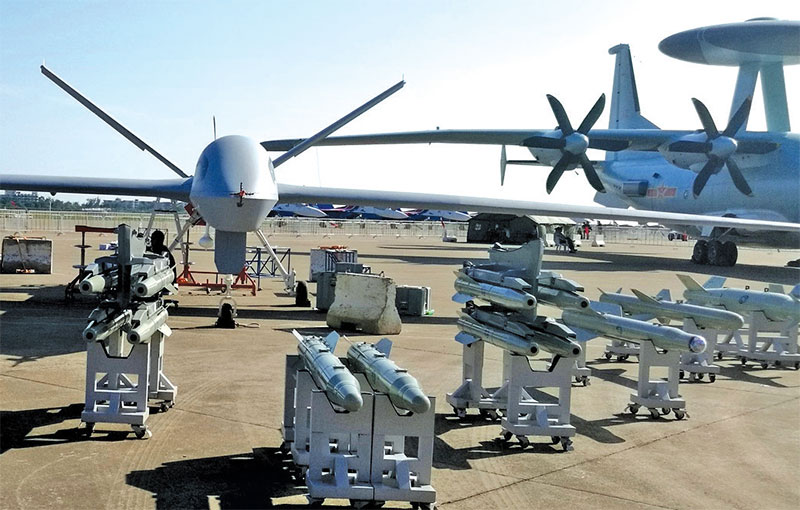State-of-the-art UAVs are the future game changers and force multipliers
 Lt Gen. B.S. Pawar (retd)
Lt Gen. B.S. Pawar (retd)
In the past decade, unmanned aerial vehicles (UAVs) have progressed from being minor players in the Intelligence and Situational Awareness (ISA) role to being a key part of combat operations as seen in Iraq and Afghanistan, with single platforms now capable of achieving the entire Find, Fix Track, Engage and Assess kill chain, thereby changing the very character of modern war. Today, UAVs are also providing exclusive capability to forces engaged in sub conventional operations, especially in the global war on terrorism.
Current technologies make UAVs more sophisticated than ever and are expanding their role in military operations. Conflicts in Ukraine, Syria and Yemen as well as areas of geopolitical conflict like Persian Gulf and East China Sea are seeing an increased use of UAVs of varying size and sophistication.
Since 2013 China has conducted periodic UAV patrols over the disputed Senkaku/ Daioyu Islands which are also claimed by Japan and Taiwan. Similarly, Iran has established at least four UAV bases bordering the Persian Gulf, and conducts regular over flights to monitor the US Naval traffic moving through the Gulf. The downing of a US Global Hawk by Iran in the Gulf of Oman in June this year and the subsequent downing of an Iranian UAV in July by the US in the Persian Gulf are clear indicators to the increasing UAV military activity worldwide.
Closer home in December 2017 an Indian Heron UAV crashed inside China on the Doklam Plateau where India and China were engaged in a military standoff over disputed territorial claims. The latest is the dropping of weapons like AK-47 rifles and grenades in the border areas of Punjab through drones by Pakistan state actors in September this year for use by terrorists in Jammu and Kashmir — the entire episode came to light when two small drones were recovered by the security forces in Punjab.
With increasing range, altitude and loiter time, UAVs now provide beyond line of sight reconnaissance, fires and over watch. This has been amply demonstrated by the extensive and successful employment of the US Global Hawk and Predator UAVs for all types of missions both ISR and combat during Operations Desert Storm and Enduring Freedom. Today, technologically advanced militaries across the world have incorporated UAVs as a new critical and combat enhancing component of their inventory.
While Israel and USA have been the pioneers in UAV development and employment, at least 24 other countries are currently developing new military unmanned aircraft for all types of ISR missions including combat — presently China appears to have the most active ongoing UAV development programs. As per data available the militaries of 95 countries have an active inventory of UAVs, with the number of countries operating UAVs increasing by an estimated 58 per cent in the last decade itself – some of these countries are believed to have licensed foreign technology for domestic production. The Israeli armed forces believe that the UAV is the future war horse and the country with the best drone technology would be the winner in a future war.

Concept of Employment
Information is an element of combat power and a combat multiplier in the hands of a commander. Field commanders require an organic, responsive, economically viable, multi-source, long endurance, near real time reconnaissance capability to collect, process and report intelligence throughout the level of conflict – 24/7.
The answer lies in the use of UAVs, with their inherent characteristics to provide the flexibility to operate in the extended battle space, thereby enabling the ground forces to see first, understand first, act first and finish decisively. Most importantly UAVs are not impeded by restraints imposed on manned systems where both the aircraft and crew could be lost – they are increasingly being employed for missions that were hitherto the domain of manned aircraft. The concept of killer / hunter UAVs for strike missions is a reality and is effectively being played out in conflicts today.
Current military UAVs perform reconnaissance as well as attack missions. Though ISR missions still remain the predominant role, other areas of employment include electronic attack, strike missions, suppression and/ or destruction of enemy air defence, network node or communications relay and combat search and rescue. The combination of loiter time and layered employment of UAVs provides the critical capability needed to support network centric operations. It is difficult to imagine how any future operation would be conducted without commanders both in the front line and rear having their situational awareness enhanced 24/7 by near real time video feeds.
India and Neighbours
Successful use of UAVs and their combat enhancing potential has generated the interest of militaries across the world. In the recent years China has unveiled a variety of UAVs with enhanced capabilities, including armed versions some of which have parallels to foreign equivalents. Majority of the units are equipped with the Caihong (CH3, CH4 & CH5) and Wing Loong (Wing Loong 1&2) types of UAVs in the MALE category and the WZ-7 also known as the ‘Soaring Dragon’ in the HALE category. The WZ-7 is known to have been deployed in Tibet and in South China Sea. What is of interest and concern is the display of two highly technologically advanced UAVs during the National Day Parade this year, the GJ-II and the WZ-8 for the first time by China.
While the GJ-II is stated to be a stealth UCAV with long range strike capability, the WZ-8 is a supersonic reconnaissance UAV. It will also be worthwhile to note that China today stands as the third largest exporter of UAVs after the US and Israel — Pakistan is a major beneficiary of these exports from China. Pakistan, unlike India, holds and operates many indigenously developed UAVs, prominent among them being the Uquaab, Jasoos, Vector and the Burraq UCAV. The Burraq has been extensively used for conducting operations in its Federally Administered Tribal Areas (FATA) against terrorists; this is most likely the Chinese Caihong (CH3/CH4) UCAV assembled/ manufactured in Pakistan. What is of concern is the reported proposed sale of 48 Chinese Wing Loong 2 high-end armed drones to Pakistan by China — some reports have also hinted at a joint venture to manufacture in Pakistan.
India has been the largest importer of UAVs over the last 30 years. Though slow off the block India, however, has not been left out of the global UAV push, with a major thrust of its armed forces modernisation plans focusing on augmenting their current meagre resources — the Israeli Searcher II, Heron (MALE) and the armed Harop self-destruct UAVs. India is already in the process of acquiring 10 Heron TP UAVs from Israel, an upgraded and armed version of Heron. This was facilitated after India became a signatory to the Missile Technology Control Regime (MTCR).
You must be logged in to view this content.

